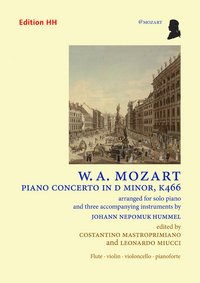W.A. Mozart: Klavierkonzert d-Moll KV 466
Wolfgang Amadeus Mozart
Piano Concerto in D minor, K466, arranged for solo piano and three accompanying instruments by Johann Nepomuk Hummel
hrsg. v. Costantino Mastroprimiano und Leonardo Miucci
Launton nr. Bicester 2013, Edition HH, Partitur und Stimmen (xi/53+12+2+16 Seiten)
ISBN 978-1-905779-97-0
Musical arrangement was central throughout the career of Johann Nepomuk Hummel (1778–1837), whose output includes about fifty transcriptions of pieces in a variety of musical genres, from opera overtures to symphonies and chamber music. Of particular importance are his adaptations of seven of Mozart’s piano concertos (K365, 456, 466, 482, 491, 503 and 537) for piano quartet (flute, violin, cello, fortepiano), not only for their historical significance in terms of Mozart reception, but for the invaluable information they provide about the performance practice of the time. Though partly looking to the contemporary aesthetic values of the piano, Hummel aimed to remain faithful to original classical principles, structure and musical language. His choice of instruments allowed him to preserve a satisfactory balance between the basso continuo, shared by the cello and piano, and the melody, shared by the piano and violin; the role of the flute was mainly to represent the typical tone of the woodwinds. Most notable with regard to performance practice are Hummel’s efforts to complete Mozart’s text in line with standard 18th-century convention, in passages where the original notation is sparse, or at least not fully comprehensive. His realizations, for example, shed light on such problematic questions as improvised embellishment and the treatment of Eingänge (lead-ins).
Hummel’s arrangement of the Piano Concerto in D minor, K466, the first of the series to appear, dates from 1827. This concerto was certainly the most popular of all Mozart’s piano concertos, both during his lifetime and after. Other composers besides Hummel arranged the work, among them Johann Baptist Cramer, Friedrich Kalkbrenner and Heinrich Anton Hoffmann, and their versions provide further possible solutions to the «incompleteness» of Mozart’s text. But it is Hummel’s arrangements, no doubt owing to the composer’s direct acquaintance with Mozart, that seem to conform most closely to original performance practice, as the Repository of Arts (1827) noted about this arrangement of K466: «Genuine melody of the sweetest kind, simple, clear, and perfect in its rhythm, abounds every where. The ‹Romanza›, for instance – what softness, what intensity of musical feeling! And all this is achieved at the least possible expense of notes. As Mozart himself said once, there is not one too many!»
